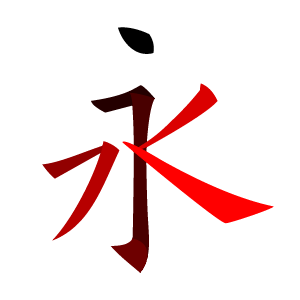
Strokes (simplified Chinese: 笔画; traditional Chinese: 壁畫; pinyin: bǐhuà) are the smallest structural units making up written Chinese characters. In the act of writing, a stroke is defined as a movement of a writing instrument on a writing material surface, or the trace left on the surface from a discrete application of the writing implement.[1] The modern sense of discretized strokes first came into being with the clerical script during the Han dynasty.[2] In the regular script that emerged during the Tang dynasty—the most recent major style, highly studied for its aesthetics in East Asian calligraphy—individual strokes are discrete and highly regularized. By contrast, the ancient seal script has line terminals within characters that are often unclear, making them nontrivial to count.
Study and classification of strokes is useful for understanding Chinese character calligraphy, ensuring character legibility. identifying fundamental components of radicals, and implementing support for the writing system on computers.
© MMXXIII Rich X Search. We shall prevail. All rights reserved. Rich X Search
